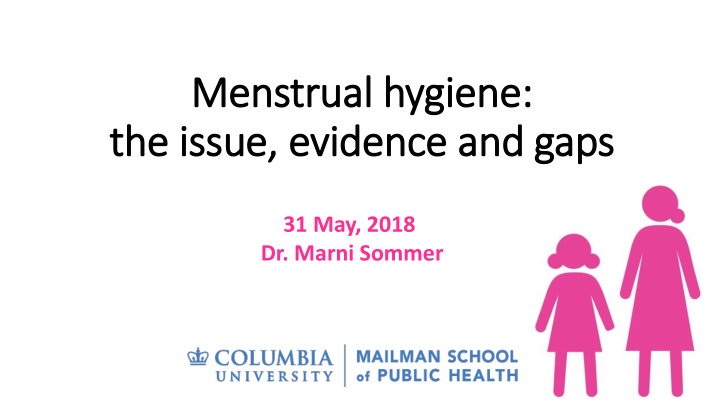



Menstrual hygiene: the issue, evidence and gaps 31 May, 2018 Dr. Marni Sommer
Definition of MHM: Women and adolescent girls are using clean menstrual management materials to absorb or collect blood that can be changed in privacy as often as necessary for the duration of the menstruation period, using soap and water for washing the body as required, and having access to facilities to dispose of used menstrual management materials. JMP, 2012
What is needed for MHM? (the essentials)
(1) In Information & Support (2) Materials & Supplies (3) Facilities (toilets with w water, , bathing & laundering/dry rying spaces) (4) Disposal & Waste Management Overcoming stigma and restrictions….ensuring safety, comfort and dignity for all.
What is the current state of MHM globally?
Silence on MHM being broken… Amid taboos surrounding menstruation, Indians debate period leave: Five countries in the world have an active menstrual-leave law. By Nikita Madhani Law In Nepal Sets Penalties For Forcing A Woman Into A Menstrual Shed Plan International created five potential emojis ….leading to action. and asked the public to vote for the winner .
Ongoing silence… TECH & SCIENCE HAVING PERIODS A ‘MAJOR BARRIER’ TO INCLUDING WOMEN IN SPORTS MEDICINE RESEARCH BY ZOË SCHLANGER ON 6/6/16 AT 6:40 PM Afghanistan: Breaking Taboos Around Menstruation Women struggle to overcome ignorant attitudes and prejudice . By Pazhman Pazhohish ….and so inaction.
Growing recognition that MHM (a cross-sectoral is issue) can serve as a proxy for meetin ing the Sustainable Develo lopment Goals ls (SDGs)
17 SDGs - 169 targets
Global trends: Over the past 5 years… • Products! Rapid growth in menstrual products globally • Increased global discourse and advocacy on MHM (conferences, MH day, websites, ‘period poverty’) • Government engagement and policies on MHM (e.g. Kenya, USA, Zambia) • Establishment of the MHM in Ten global agenda, five key priorities for 2014-2024 • Improved technical guidance on MHM (e.g. Agnes Makanyi, Ministry of Health, Menstrual Hygiene Matters, 2012) Kenya at the Virtual Conference for MHM in Schools (October 2017)
The Evidence Base: What do we know?
Rich qualitative evidence base on… • MHM challenges facing girls in schools • Psychosocial impact of MHM • Cultural taboos and stigma around menstruation • MHM practices, including types of materials, washing, learning about menstruation • MHM challenges faced by displaced populations
MHM and Schools • 14 country WASH in Schools (WinS4Girls) • Multiple trials and evaluations testing various MHM packages and products (e.g. Cups/Cash in Kenya, MENISCUS in Uganda, M&E of NGO programs) • Development of puberty books & MHM education resources • Cross-sectoral engagement (WASH, Education, Gender, Health)
Engaging boys & men on MHM • Development of boy’s puberty books • Small body of evidence (e.g. India, Eritrea) • Engaging in MHM emergency response (infographic)
Analyzing Education Policies…for inclusion of MHM
MHM in in Emergencies • Existing humanitarian response operations inadequate in addressing MHM • Development of guidance for cross-sectoral response efforts • Defined sectoral roles & strategies for collaboration • Growing (but limited) evidence
What are the gaps in the evidence? (1) Barriers beyond schools (2) Measuring intervention impact (effectiveness, , efficiency)
MHM in t the Workplace: Need to identify fy barriers, impact & solutions
MHM in peri-urban and urban slums: Need to identify fy barriers, , impact & solutions Kibera Slum, Nairobi, Kenya
Measuring MHM in interv rventions Need for improved measures & more rigorous evaluations
More specifically: • More rigorous quantitative research with validated new measures (e.g. self-efficacy, classroom engagement) • Increased dissemination of learning/case studies about what works and what doesn’t work for MHM • Research that measures a holistic response to MHM (information, toilets, waste management, etc.) • More conclusive evidence on the relationship of MHM and health, social, educational outcomes
Gaps & Opportunities for building MHM evidence: • Female-friendly toilets – how to design and maintain female-friendly toilets within school, workplace and public settings, and displacement contexts • Menstrual waste disposal - Mechanisms for discreet disposal of menstrual waste & its management • Maintenance of menstrual products - Methods for discreetly washing and drying menstrual materials • Male engagement - How best to engage boys and men in supporting females with MHM? • MHM in the workplace, in slums – What are the Collaborate! challenges faced by female workers, by females living in slums?
Essential to keep menstruating girls and women at the center… as the knowers of their own lives.
The way forward…
Recommend
More recommend